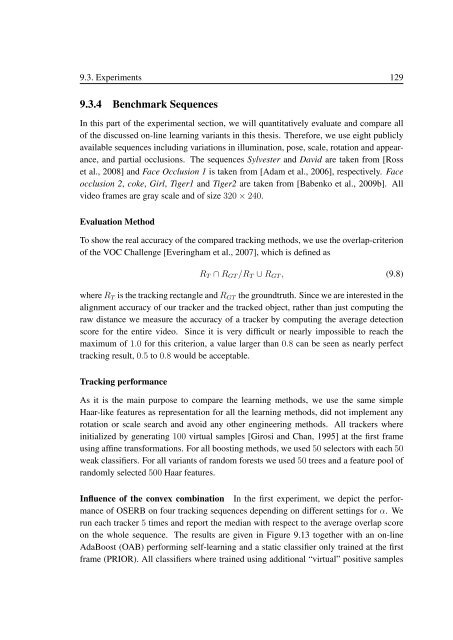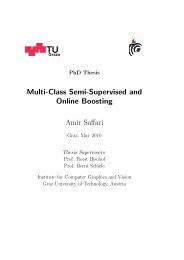PhD Thesis Semi-Supervised Ensemble Methods for Computer Vision
PhD Thesis Semi-Supervised Ensemble Methods for Computer Vision
PhD Thesis Semi-Supervised Ensemble Methods for Computer Vision
You also want an ePaper? Increase the reach of your titles
YUMPU automatically turns print PDFs into web optimized ePapers that Google loves.
9.3. Experiments 129<br />
9.3.4 Benchmark Sequences<br />
In this part of the experimental section, we will quantitatively evaluate and compare all<br />
of the discussed on-line learning variants in this thesis. There<strong>for</strong>e, we use eight publicly<br />
available sequences including variations in illumination, pose, scale, rotation and appearance,<br />
and partial occlusions. The sequences Sylvester and David are taken from [Ross<br />
et al., 2008] and Face Occlusion 1 is taken from [Adam et al., 2006], respectively. Face<br />
occlusion 2, coke, Girl, Tiger1 and Tiger2 are taken from [Babenko et al., 2009b]. All<br />
video frames are gray scale and of size 320 × 240.<br />
Evaluation Method<br />
To show the real accuracy of the compared tracking methods, we use the overlap-criterion<br />
of the VOC Challenge [Everingham et al., 2007], which is defined as<br />
R T ∩ R GT /R T ∪ R GT , (9.8)<br />
where R T is the tracking rectangle and R GT the groundtruth. Since we are interested in the<br />
alignment accuracy of our tracker and the tracked object, rather than just computing the<br />
raw distance we measure the accuracy of a tracker by computing the average detection<br />
score <strong>for</strong> the entire video. Since it is very difficult or nearly impossible to reach the<br />
maximum of 1.0 <strong>for</strong> this criterion, a value larger than 0.8 can be seen as nearly perfect<br />
tracking result, 0.5 to 0.8 would be acceptable.<br />
Tracking per<strong>for</strong>mance<br />
As it is the main purpose to compare the learning methods, we use the same simple<br />
Haar-like features as representation <strong>for</strong> all the learning methods, did not implement any<br />
rotation or scale search and avoid any other engineering methods. All trackers where<br />
initialized by generating 100 virtual samples [Girosi and Chan, 1995] at the first frame<br />
using affine trans<strong>for</strong>mations. For all boosting methods, we used 50 selectors with each 50<br />
weak classifiers. For all variants of random <strong>for</strong>ests we used 50 trees and a feature pool of<br />
randomly selected 500 Haar features.<br />
Influence of the convex combination In the first experiment, we depict the per<strong>for</strong>mance<br />
of OSERB on four tracking sequences depending on different settings <strong>for</strong> α. We<br />
run each tracker 5 times and report the median with respect to the average overlap score<br />
on the whole sequence. The results are given in Figure 9.13 together with an on-line<br />
AdaBoost (OAB) per<strong>for</strong>ming self-learning and a static classifier only trained at the first<br />
frame (PRIOR). All classifiers where trained using additional “virtual” positive samples



